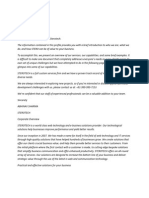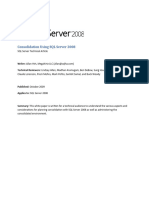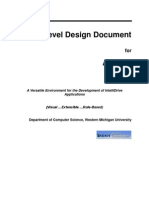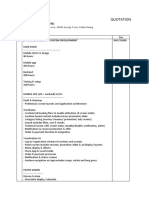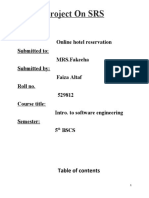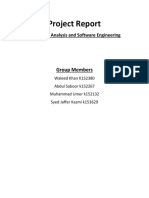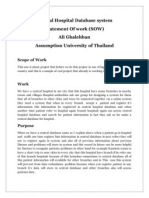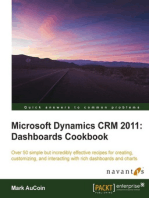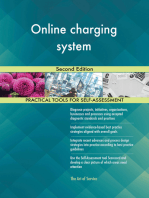Vision - Scope. Time-Tracker 2.0
Uploaded by
ВиталийВладимировичVision - Scope. Time-Tracker 2.0
Uploaded by
ВиталийВладимировичVision and Scope Document
for
TimeTracker 2.0
Version 0.3
Prepared by Sarah Mercier
Strictly Business
9/2/10
Copyright 1999 by Karl E. Wiegers. Permission is granted to use, modify, and distribute this document.
Vision and Scope for TimeTracker 2.0
Page ii
TableofContents
Table of Contents.................................................................................................................ii
Revision History..................................................................................................................ii
1. Business Requirements..................................................................................................1
1.1. Background............................................................................................................1
1.2. Business Opportunity.............................................................................................1
1.3. Business Objectives and Success Criteria..............................................................1
1.4. Customer or Market Needs.....................................................................................1
1.5. Business Risks........................................................................................................1
2. Vision of the Solution....................................................................................................2
2.1. Vision Statement.....................................................................................................2
2.2. Major Features........................................................................................................2
2.3. Assumptions and Dependencies.............................................................................2
3. Scope and Limitations...................................................................................................2
3.1. Scope of Initial Release..........................................................................................2
3.2. Scope of Subsequent Releases...............................................................................2
3.3. Limitations and Exclusions....................................................................................3
4. Business Context...........................................................................................................3
4.1. Stakeholder Profiles...............................................................................................3
4.2. Project Priorities.....................................................................................................4
4.3. Operating Environment..........................................................................................4
RevisionHistory
Name
Date
Reason For Changes
Version
Sarah Mercier
Sarah Mercier
08/26/10
08/31/10
0.1
0.2
Sarah Mercier
9/2/10
Initial release.
Updated entire document to better reflect
customer needs and reorganized material to
improve readability.
Modified features and updated role list.
0.3
Vision and Scope for TimeTracker 2.0
Page 1
1. Business Requirements
The current TimeTracker system is run as a website on the Strictly Business servers. All data sanitation
and privacy are handled by the application. The new system will be written using Google App Engine.
The migration of TimeTracker to Google App Engine will facilitate easier integration of other such as
Google Mail, Talk and Calendar in future releases. Future releases will also have invoice generation
ability. The new system will allow for custom branding and themes.
The business requirements provide the foundation and reference for all detailed requirements
development, in essence why the project is being undertaken and the ultimate value it will provide, both
to the customers and to the business.
1.1. Background
Previously, the tracking of time on projects and clients as been handled through the TimeTracker web
application hosted on the SBCS servers. By moving to Google App Engine, those servers that were
originally housing TimeTracker information will then be free for other uses.
1.2. Business Opportunity
By storing data on Googles cloud, servers will be freed up to be used for other projects.
Migration of TimeTracker to Google App Engine will allow for easier integration of other
Google applications such as Google Mail, Calendar and Talk.
Custom branding will allow the application to be used by many different companies, making it
more marketable.
With the ease of report generation, project managers and clients will be able to see the status of
their project (e.g., how many hours they have left, how many hours they have used, etc.) which
could potentially free up project manager and developer time as well as give clients peace of
mind.
The development of an Android application that could act as a stopwatch and submit time from
mobile devices could allow employees to focus more on their projects and less on the time spent
on each objective.
1.3. Business Objectives and Success Criteria
Business Objectives:
BO-1:
BO-2:
BO-3:
BO-4:
BO-5:
Migration to Google App Engine, freeing servers for other uses.
Integration of other Google Apps.
Marketability to other companies through custom branding and themes.
Allow clients and project managers to easily see status of their project.
Development of an Android application that would allow employees to manage time
automatically from their mobile devices.
Success Criteria:
SC-1:
SC-2:
SC-3:
SC-4:
Full migration to Google Apps.
Integration of Google Mail, Calendar and Talk.
The ability of other companies to customize and use the application.
The ability of clients/project managers to easily see the status of their project.
Vision and Scope for TimeTracker 2.0
SC-5:
Page 2
The ability to download an Android application with stopwatch capability that could
submit time directly to TimeTracker 2.0 from a mobile device.
1.4. Customer or Market Needs
This section will provide the rationale for developing this system from a customers and end-users (i.e.,
business employees) perspective. Migrating the application to Google App Engine would allow for a
potentially larger customer base as there would be more space on the servers to work with.
The ability for project managers and clients to be able to easily login and see the status of their project
could facilitate better project management. Clients would have better peace of mind, knowing at any
point and time their remaining hours, and project managers could potentially have more free time if they
are not constantly communicating with the client on the status of their project.
The development of an Android application that had a stopwatch capability would allow employees to
simply start and stop the watch, then submit time for projects and clients directly from their phone,
eliminating the need to constantly be aware of starting and stopping times and allow them to focus more
clearly on their project goals.
1.5. Business Risks
RI-1:
RI-2:
RI-3:
RI-4:
RI-4:
Some users may be wary of storing information on the Google servers due to
privacy.
Generation of reports could fail, resulting in potential monetary loss or lawsuit.
Database could fail due to breach or system failure.
Application could store data incorrectly, resulting in incorrect payment of
employees.
Android stopwatch could calculate time incorrectly and employee could be paid
wrong amount of money, which could in turn cause a client/project to be charged
incorrectly.
2. Vision of the Solution
This section provides the context for making decisions throughout the course of the product
development life cycle, without including detailed functional requirements or project planning
information.
2.1. Vision Statement
For project managers and clients, the new system will allow for better project management and
peace of mind due to their ability to check on the status of their project at any point and time.
Accounting department members will appreciate the new system as it will allow them to
streamline the payroll process and eliminate the need for TimeSlips. Business communication in
general will improve due to the integration of the business calendar, mail and instant messaging
capabilities all integrated into the same system as the payroll. Allowing employees to use a
stopwatch application on their phone to track time which then submits to the online database
could allow for easier time management.
2.2. Major Features
FE-1:
FE-2:
Data and application hosting on Google Apps
Log and submit time spent on projects and clients
Vision and Scope for TimeTracker 2.0
FE-3:
FE-4:
FE-5:
FE-6:
FE-7:
FE-8:
FE-9:
FE-10:
FE-11:
Page 3
Manage leave time
Generate, print and export reports
Employee management
Time approval and rejection with notification
Integration of Google Calendar, Mail and Talk
Brand customization
Time management through Android application
Impersonate other users
Project/Client Management
2.3. Assumptions and Dependencies
Assumptions:
AS-1:
AS-2:
AS-3:
AS-4:
No more than 500 MB of data stored on Google App Engine.
No more than 5 million page views monthly.
Users have a Google Account with which they can login.
Users have javascript enabled.
Dependencies
DE-1:
Free Google App Engine account.
DE-2:
jQuery javascript library (for user interface).
3. Scope and Limitations
The project scope defines the concept and range of the proposed solution, what will not be
included in the product, and a reference frame against which proposed features and requirements
changes can be evaluated.
3.1. Scope of Initial and Subsequent Releases
Feature
FE-1
FE-2
FE-3
FE-4
FE-5
FE-6
FE-7
Release 1
Fully implemented.
Fully implemented.
Implemented if time
permits (medium priority).
Not implemented.
Fully implemented.
Not implemented.
Not implemented.
FE-8
Not implemented.
FE-9
FE-10:
FE-11:
Not implemented.
Not implemented.
Fully implemented.
Release 2
Release 3
Fully implemented.
Fully implemented.
Fully implemented.
Implemented if time
Fully implemented.
permits (medium priority).
Not implemented.
Implemented if time
permits (medium priority).
Begin implementation.
Fully implemented.
Not implemented.
Fully implemented
Vision and Scope for TimeTracker 2.0
Page 4
3.2. Limitations and Exclusions
EX-1:
EX-2:
EX-3:
EX-4:
Support of storage methods other than Google App Engine.
Automatic recording and logging of time.
Centralized system supporting time tracking by multiple companies.
Online payment of any kind.
4. Business Context
This section summarizes some of the business issues around the project, including profiles of
major customer categories, assumptions that went into the project concept, and the management
priorities for the project.
4.1. Stakeholder Profiles
Stakeholder
Employee
Project manager
and Project
Leader
System
Administrator
Accounting
Department
Member
Major Value
Attitudes
Streamlined time
management
(both
project/client and
leave) process,
ability to receive
notifications
regarding time
Streamlined
process, easier
project time
management
through report
generation,
ability to push
notifications
Would like to easily
manage time (both
project/client related
and leave), but
expect a very easy,
user-friendly
interface
Ease of application
process, reliability
Interface must be
easy to use and
compatible with
all major browsers
and operating
systems
See product as way
to free up their time
and make the entire
time management
process more
automated, but again
need a very simple,
user-friendly
interface to manage
database
See new system as a
way to easily store
sensitive data
securely and
customize the web
interface to match
their companys
style
Streamlined
administrative
capabilities, better and
easier report generation
Interface must be
compatible with
all major browsers
and operating
systems
Ease of customization,
security and privacy of
data
Interface must be
reusable and
application must
have ability to be
ported
See new system as a
way to more easily
manage timesheets
Ease of report generation
and ability to export
reports
Reports must be
generated in
correct format and
able to be
customized and
exported easily
Easier database
management
through Google
App Engine,
easier web
application
management
through custom
branding
Streamlined
payroll process
Major Interests
Constraints
Vision and Scope for TimeTracker 2.0
Client
Ability to view
project status at
any given time
Page 5
Would like an easy
to use interface
which will allow
them to quickly and
clearly see
information
regarding project(s)
Ease of generating reports
regarding their particular
project(s)
Interface must be
easy to use and
compatible with
all major browsers
and operating
systems
4.2. Project Priorities
Dimension
Schedule
Driver
(state objective)
Constraint
(state limits)
Degree of Freedom
(state allowable range)
All features with the
exclusion of branding and
the Android application
must be finished by end
of 2010-2011 academic
year
Basic functionality of all initial
features must be implemented by
initial release
Initial Release by middle
of Fall 2010 Semester,
Second Release by end
of Fall 2010 semester,
Final Release by end of
Spring 2011 semester
Features
Quality
Staff
Maximum team size is 1
developer
No funds available
Cost
4.3. Operating Environment
OE-1:
OE-2:
OE-3:
OE-4:
OE-5:
OE-6:
OE-7:
System is not dependent on geographical areas.
System shall operate in newest versions of all web browsers.
There should be no constraint on users being able to access the system at a given time.
Data is generated by online forms and stored in the Google App Engine database.
Continuous service is preferred, but as long as there is no data loss, minor service
interruptions can be tolerated.
Personal data will be stored in the database, so the Google App Engine database must be
secure.
jQuery javascript library will be needed to create the user interface for the system.
You might also like
- System Requirment Specifications For Online Revenue Recovery67% (3)System Requirment Specifications For Online Revenue Recovery61 pages
- Software Requirement Engineering ProjectNo ratings yetSoftware Requirement Engineering Project31 pages
- A Software Design Specification TemplateNo ratings yetA Software Design Specification Template12 pages
- Smartptt Plus Control Room Solution For MototrboNo ratings yetSmartptt Plus Control Room Solution For Mototrbo4 pages
- Design, Development and Performance Evaluation of Multiprocessor Systems On FpgaNo ratings yetDesign, Development and Performance Evaluation of Multiprocessor Systems On Fpga161 pages
- Software Requirement Specification: Online Job Portal100% (1)Software Requirement Specification: Online Job Portal12 pages
- Functional and Nonfunctional Requirements Specification and TypesNo ratings yetFunctional and Nonfunctional Requirements Specification and Types12 pages
- E-Commerce Website (Robo Shop) : Software Requirements SpecificationNo ratings yetE-Commerce Website (Robo Shop) : Software Requirements Specification10 pages
- System Requirement Specification Document: Pushp NaiduNo ratings yetSystem Requirement Specification Document: Pushp Naidu13 pages
- Software Requirements Specification: Packet Sniffing Using WiresharkNo ratings yetSoftware Requirements Specification: Packet Sniffing Using Wireshark8 pages
- A Service-Oriented Approach To EMaintenance of Complex Technical SystemsNo ratings yetA Service-Oriented Approach To EMaintenance of Complex Technical Systems212 pages
- Software Requirement Specification For Financial Management System100% (1)Software Requirement Specification For Financial Management System1 page
- System Center 2012 Configuration Manager Design QuestionnaireNo ratings yetSystem Center 2012 Configuration Manager Design Questionnaire26 pages
- Airtel Tigo Ghana - BRD - v1.0 (00000002)No ratings yetAirtel Tigo Ghana - BRD - v1.0 (00000002)16 pages
- The Log - What Every Software Engineer Should Know About Real-Time Data's Unifying Abstraction - LinkedIn EngineeringNo ratings yetThe Log - What Every Software Engineer Should Know About Real-Time Data's Unifying Abstraction - LinkedIn Engineering38 pages
- Quotation - MMCineplex by Digital Leap FINALNo ratings yetQuotation - MMCineplex by Digital Leap FINAL12 pages
- Dictionary of Non-Functional RequirementsNo ratings yetDictionary of Non-Functional Requirements3 pages
- London Ambulance Dispatch System Failure - The Case For Prince2?No ratings yetLondon Ambulance Dispatch System Failure - The Case For Prince2?49 pages
- En - Security Center Administrator Guide 5.2100% (1)En - Security Center Administrator Guide 5.2892 pages
- Physical Education and Health 12: 3 Quarter Week 3No ratings yetPhysical Education and Health 12: 3 Quarter Week 36 pages
- Stakeholder Analysis Matrix (3.3.2) (10.1)No ratings yetStakeholder Analysis Matrix (3.3.2) (10.1)1 page
- System Oriented Sustainable Supply Chain Management Innovations in Automotive Industry - SKODA Auto Case StudyNo ratings yetSystem Oriented Sustainable Supply Chain Management Innovations in Automotive Industry - SKODA Auto Case Study7 pages
- Pattern Recognition Letters: Xiaohua Xia, Suping Fang, Yan XiaoNo ratings yetPattern Recognition Letters: Xiaohua Xia, Suping Fang, Yan Xiao6 pages
- Sample Weber Health Assessment Nursing 7th100% (1)Sample Weber Health Assessment Nursing 7th30 pages
- 48.lamp Illumination Control System Using Sensor CircuitNo ratings yet48.lamp Illumination Control System Using Sensor Circuit4 pages
- Mechanical Liquid Flow Switch: Penn Commercial RefrigerationNo ratings yetMechanical Liquid Flow Switch: Penn Commercial Refrigeration2 pages
- On The Method of Ship's Transoceanic Route PlanningNo ratings yetOn The Method of Ship's Transoceanic Route Planning8 pages
- Theology and The Curriculum: Univer1Jit11, Is Still Seen As A Major Philosophical Statement On The NaNo ratings yetTheology and The Curriculum: Univer1Jit11, Is Still Seen As A Major Philosophical Statement On The Na11 pages
- System Requirment Specifications For Online Revenue RecoverySystem Requirment Specifications For Online Revenue Recovery
- Design, Development and Performance Evaluation of Multiprocessor Systems On FpgaDesign, Development and Performance Evaluation of Multiprocessor Systems On Fpga
- Software Requirement Specification: Online Job PortalSoftware Requirement Specification: Online Job Portal
- Functional and Nonfunctional Requirements Specification and TypesFunctional and Nonfunctional Requirements Specification and Types
- E-Commerce Website (Robo Shop) : Software Requirements SpecificationE-Commerce Website (Robo Shop) : Software Requirements Specification
- System Requirement Specification Document: Pushp NaiduSystem Requirement Specification Document: Pushp Naidu
- Software Requirements Specification: Packet Sniffing Using WiresharkSoftware Requirements Specification: Packet Sniffing Using Wireshark
- A Service-Oriented Approach To EMaintenance of Complex Technical SystemsA Service-Oriented Approach To EMaintenance of Complex Technical Systems
- Software Requirement Specification For Financial Management SystemSoftware Requirement Specification For Financial Management System
- System Center 2012 Configuration Manager Design QuestionnaireSystem Center 2012 Configuration Manager Design Questionnaire
- The Log - What Every Software Engineer Should Know About Real-Time Data's Unifying Abstraction - LinkedIn EngineeringThe Log - What Every Software Engineer Should Know About Real-Time Data's Unifying Abstraction - LinkedIn Engineering
- London Ambulance Dispatch System Failure - The Case For Prince2?London Ambulance Dispatch System Failure - The Case For Prince2?
- Microsoft Dynamics CRM 2011: Dashboards CookbookFrom EverandMicrosoft Dynamics CRM 2011: Dashboards Cookbook
- Physical Education and Health 12: 3 Quarter Week 3Physical Education and Health 12: 3 Quarter Week 3
- System Oriented Sustainable Supply Chain Management Innovations in Automotive Industry - SKODA Auto Case StudySystem Oriented Sustainable Supply Chain Management Innovations in Automotive Industry - SKODA Auto Case Study
- Pattern Recognition Letters: Xiaohua Xia, Suping Fang, Yan XiaoPattern Recognition Letters: Xiaohua Xia, Suping Fang, Yan Xiao
- 48.lamp Illumination Control System Using Sensor Circuit48.lamp Illumination Control System Using Sensor Circuit
- Mechanical Liquid Flow Switch: Penn Commercial RefrigerationMechanical Liquid Flow Switch: Penn Commercial Refrigeration
- On The Method of Ship's Transoceanic Route PlanningOn The Method of Ship's Transoceanic Route Planning
- Theology and The Curriculum: Univer1Jit11, Is Still Seen As A Major Philosophical Statement On The NaTheology and The Curriculum: Univer1Jit11, Is Still Seen As A Major Philosophical Statement On The Na












